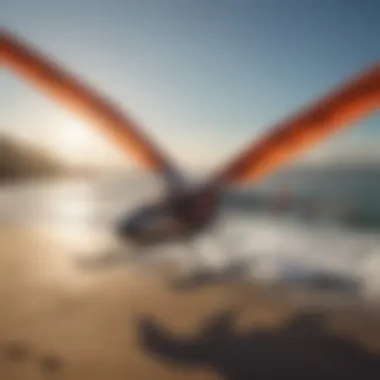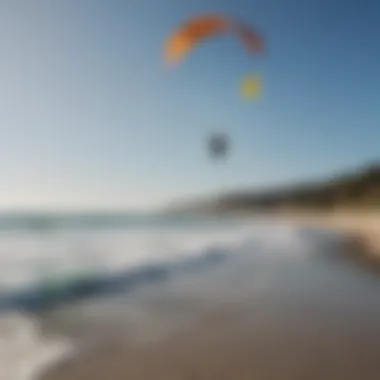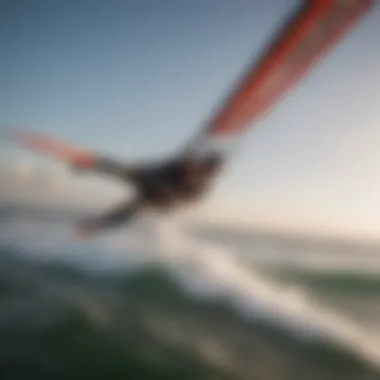An Exploration of Slingwing: The New Dimension of Kitesurfing


Intro
Slingwing has emerged as a groundbreaking innovation that is reshaping the landscape of kitesurfing. Combining elements of wing foiling and traditional kitesurfing, this versatile tool opens up a new dimension for riders. Unlike standard kites, slingwings offer unique advantages in terms of ease of use and adaptability, making them appealing for a broad range of kitesurfing enthusiasts, from beginners to seasoned professionals. This article will explore the various facets of slingwing, encompassing its design, practical benefits, and community influence, all while providing insights to enhance the reader’s understanding of this evolving sport.
Equipment Reviews
Kites
In the world of slingwing kitesurfing, various models present distinctive features tailored to varying riding conditions and styles. The Duotone Slick is known for its lightweight construction and optimized performance, designed to maximize wind efficiency. Another example is the Naish S26, which emphasizes stability and control, offering great performance in diverse wind conditions. Incorporating advanced materials enhances durability and responsiveness. Here are some factors to consider with kite selection:
- Kite Shapes: The design can influence aerodynamics and handling. Each shape caters to specific riding styles.
- Sizes: Size impacts power, speed, and responsiveness. Riders must choose based on their weight and conditions.
- Materials: Quality materials extend the lifespan of kites and improve overall performance.
Boards
Kiteboarding boards available today differ significantly based on design and intended use. The Airush Switch is appreciated for its all-around versatility and ease of use. It is suitable for both beginners and advanced riders. The Slingshot Space Rhino, on the other hand, focuses on performance in tricky conditions and bigger waves. Boards are generally categorized into:
- Twintips: Great for jumping and freestyle tricks.
- Directional Boards: Designed for wave riding and downwind conditions.
Accessories
Proper accessories enhance the overall kitesurfing experience and ensure safety. Essential items include:
- Harnesses: Aid in distributing pull from the kite across the body effectively.
- Lines: Durable and reliable lines are crucial to avoid accidents during flight.
- Pumps: Efficient pumps assist in quick setup, influencing pre-ride time.
- Safety Gear: A reliable impact vest and helmet are essential for rider protection.
Travel Destinations
Popular Spots
There are numerous renowned locations for kiteboarding globally. In places like Maui, Hawaii, consistent trade winds create ideal conditions for all levels. Tarifa, Spain, is famous for its strong winds and beautiful beaches, attracting many water sports enthusiasts.
Off the Beaten Path
For those seeking lesser-known sites, Lanzarote, Canary Islands, offers stunning landscapes and reliable wind patterns. Another hidden gem is Punta Chame, Panama, known for its calm waters and uncrowded spots.
Techniques and Tutorials
Beginner Guides
For beginners tackling slingwing, mastering the launch, riding, and landing is vital. Start with a focus on:
- Launching: Practice proper positioning to reduce drag and improve lift.
- Riding: Use a gentle stance, leaning back slightly to maintain balance.
- Turning: Keep the kite low to enhance control when changing direction.
Advanced Skills
Advanced riders can explore more intricate moves such as:
- Jumps: Learn to use the kite to generate lift before launching.
- Tricks: Combine maneuvers for freestyle displays.
- Wave Riding: Utilize the natural elements of waves to enhance performance.
Safety Guidelines
Weather Conditions
Understanding weather patterns is key for safety. Riders should monitor:
- Wind Proficiency: Know your skill level concerning different wind speeds.
- Current and Tides: Recognize how these elements influence your ride.
Emergency Protocols
Injuries and accidents can happen, so familiarity with emergency protocols is vital. Quick rescue tactics include providing clear signals and swimming to the board if necessary.
Equipment Maintenance


Routine checks on equipment can prolong its life and ensure safety. Regularly inspect for wear on lines and check for any damage to the kite or board.
"Successful kitesurfing demands attention to detail and respect for changing conditions."
The slingwing phenomenon exemplifies the dynamic evolution of kitesurfing, bringing renewed interest to the sport. This exploration aims to equip enthusiasts with knowledge for safe, enjoyable, and proficient riding.
Prelude to Slingwing
Slingwing represents a significant advancement in the kitesurfing arena. This hybrid tool, combining the dynamics of traditional kites with the mobility of a wing, has reshaped how athletes approach both water and land sports. The significance of Slingwing extends beyond mere recreation; it embodies innovation, versatility, and adaptability in the sport of kitesurfing. Understanding this topic is essential for anyone looking to optimize their experience as a rider, whether seasoned or novice.
The benefits of utilizing a Slingwing are manifold. Riders appreciate the lightweight design that allows for easy transport. Stability in diverse wind conditions is another advantage. The ability to engage in various riding styles—from freestyle tricks to cruising—enhances its appeal. Moreover, fostering a comprehensive understanding of Slingwing technology provides kitesurfers with the insight needed to select the right equipment and techniques for their style.
In addition to the practical aspects, the Slingwing phenomenon stimulates a growing community. Enthusiasts share tips, experiences, and best practices through various platforms, enriching the overall kitesurfing culture. By exploring the essential elements of Slingwing, riders become more informed participants in this vibrant community.
Defining Slingwing
Slingwing is a type of wing that serves as a propulsion device for kitesurfers. Its structure typically includes a solid frame covered by fabric, designed to harness the wind efficiently. Riders hold the Slingwing in their hands, allowing for increased control and precision. Unlike traditional kites, which are attached to a board through a harness, the Slingwing offers a more direct and responsive interaction. This unique design allows for both standing and seated positions, adapting to rider preferences.
The Slingwing's capabilities extend beyond water sports. Riders can use it on land or snow, further illustrating its versatility. Various sizes and shapes of Slingwings exist, catering to different wind conditions and rider requirements. Each Slingwing offers a distinct experience, making it an attractive option for enthusiasts seeking to explore new dimensions in kitesurfing.
Evolution of Slingwing Technology
The evolution of Slingwing technology is a testament to the ongoing innovation in watersports. Initially, kitesurfing relied solely on traditional kites where maneuverability and wind direction played crucial roles in performance. However, as athletes sought more flexibility, the concept of a hand-held wing emerged.
Early prototypes of Slingwings were rudimentary, often lacking the stability and control that riders now expect. As materials and design techniques advanced, so did the performance of Slingwings. Modern Slingwings utilize lightweight materials like ripstop nylon and durable fabrics that resist wear and tear. Designers have also refined the shape and aerodynamic features, allowing for smoother rides and enhanced performance in varying wind conditions.
Today’s Slingwings exhibit an impressive range of technological advancements. From improved inflation systems to adjustable strut placements, features are tailored to enhance rider experience. Understanding this evolution provides context for both the function and appeal of Slingwings, allowing riders to appreciate their tools while maximizing performance in their chosen environment.
"The Slingwing is not just a tool; it represents a complete shift in how we enjoy kitesurfing, changing our interaction with the wind and water."
Understanding the Mechanics
Understanding the mechanics of slingwing usage is vital for anyone looking to explore this innovative kitesurfing accessory. The unique construction and functionality play a significant role in its applications and performance in various conditions. This section will discuss the core components, how slingwings differ from traditional kites, and the aerodynamics behind their operation. Grasping these elements is essential for both new participants and experienced riders as it enables better decision-making regarding equipment choice and usage techniques.
Core Components of a Slingwing
A slingwing consists of several key components that ensure its effective performance. These parts must work in harmony to offer the rider enhanced control and efficiency on the water or other terrains.
- Canopy: The canopy is the most visible part. Designed to catch wind, it provides lift and stability. The material used is lightweight yet durable, often made from ripstop nylon or polyester.
- Handles: Unlike traditional kites that use lines, slingwings feature handles. These allow for a more direct connection and easier manipulation, enhancing rider responsiveness.
- Struts: These are the support structures that maintain the shape of the canopy. Properly designed struts contribute to the wing's overall aerodynamics.
- Inflatable Bladders: Many models integrate inflatable components. They help with buoyancy and ensure that the wing retains its shape both in and out of the water.
Understanding these basic components is essential for riders to ensure they select the right equipment suitable for their skill level and desired riding conditions.
How Slingwings Differ from Traditional Kites
Slingwings represent a departure from conventional kite designs in several distinct ways. Primarily, the experience of riding a slingwing contrasts greatly with that of traditional kites.
- Ease of Use: Beginners find slingwings simpler to operate. The handles allow for intuitive control compared to lines connecting to a kite, which can be perplexing.
- Versatility: Slingwings can adapt to various conditions and can be used for both kitesurfing and landboarding. Traditional kites are often limited to water sports, restricting their applications.
- Weight Distribution: The weight distribution in a slingwing is different. This allows riders to feel less fatigue over prolonged use, especially during longer sessions.
- Adjustment and Control: With a slingwing, riders can make quick adjustments and utilize body movements to redirect the wing, allowing for more dynamic control adjustability.
These differences enhance the overall riding experience, offering a fresh approach that appeals to a diverse range of kitesurfers.
Aerodynamics of Slingwing Usage
The aerodynamics of a slingwing are fundamental to its performance. Understanding how air moves over and under the wing is crucial for optimizing use and achieving desired maneuvers.
- Lift Generation: Similar to conventional wings, slingwings create lift through their shape. As the wind passes over the canopy, it lowers pressure on the top compared to the bottom, resulting in upward thrust.
- Angle of Attack: Riders control the angle of attack. By adjusting this angle, they can optimize lift and responsiveness, impacting how quickly the wing reacts to changes in wind conditions.
- Drag Management: Minimizing resistance is key. Slingwings are engineered with aerodynamic profiles that reduce drag, allowing for smoother gliding through the air.
"The ability to manipulate aerodynamics is what sets skilled riders apart in slingwing kiting. Studying wind patterns can greatly enhance performance."
Overall, a comprehension of slingwing mechanics, including its components and aerodynamic attributes, forms a solid foundation for any kitesurfer. This knowledge not only improves riding techniques but also fosters a deeper appreciation of the sport itself.
Advantages of Using a Slingwing


The advantages of using a slingwing are substantial, particularly for both enthusiasts and seasoned kitesurfers. This new dimension of kitesurfing provides riders with unique benefits that are not easily obtainable with traditional kites. The design and functionality of slingwings allow for a more adaptable and user-friendly experience. These benefits include portability, versatility in various riding conditions, and improved control and responsiveness.
Portability and Convenience
One significant advantage of slingwings is their portability. Unlike traditional kites, slingwings are often lighter and more compact. This makes them easier to transport to remote locations or travel with. Riders can quickly pack their gear in a smaller space, which is especially valuable for kitesurfers who enjoy traveling for their sport. The minimalistic design also contributes to the ease of setup and takedown.
- Easy Handling: A slingwing can be set up in minutes. Even beginners will find this aspect appealing.
- Storage Efficiency: Riders can store their gear in small bags and use available storage space efficiently.
Slingwings do not require a lot of additional equipment like traditional kites do, meaning less hassle when hitting the beach. The convenience aspect cannot be understated as it increases the time riders spend enjoying the water rather than setting up.
Versatility in Riding Conditions
Slingwings excel in various wind and water conditions. Their design allows for effective performance across diverse riding environments, from light winds to stronger gusts.
- Wide Wind Range: Many riders appreciate that slingwings maintain stability even in unpredictable conditions.
- All-Season Use: Unlike traditional kites, which may be limited by wind strength, slingwings can be adapted for different seasons, whether on snow or water.
This versatility appeals to both casual riders and serious athletes. It encourages experimentation in diverse settings, empowering kitesurfers to develop their skills and comfort with different techniques. Riders find themselves more likely to embrace challenging conditions thanks to the entrance of slingwings into their kit.
Improved Control and Responsiveness
The control and responsiveness of slingwings are additional benefits that enhance the overall riding experience. Riders gain an intuitive understanding of how their movements affect the wing. This connection allows for more precise handling compared to many traditional kites.
- Immediate Feedback: Slingwings react quickly to hand movements, which aids in executing maneuver
- Enhanced Feeling: Riders often report a more connected sensation with the water and wind, fostering better kite-handling skills.
With improved control, riders can easily transition between different speeds and maneuvers. This adaptability is crucial when navigating through various conditions, making it safer and more enjoyable.
"The design of the slingwing isn't just an advancement; it’s a reimagining of what kitesurfing can be."
Techniques for Effective Slingwing Riding
Understanding the techniques for effective Slingwing riding is essential for maximizing performance and safety. The sports demands both mental and physical skills. Different techniques cater to varied skill levels and riding conditions. Mastery of these techniques can create an enjoyable experience while minimizing risks associated with navigation and maneuvering.
Basic Techniques for Beginners
For those new to Slingwing riding, starting with basic techniques is crucial. Novices should focus on mastering the following:
- Grip and Stance: Beginners should hold the handles with a firm grip, yet relaxed enough to allow for quick adjustments. A wide stance can offer better balance when starting to ride.
- Launching: Learn to launch the Slingwing against the wind. Positioning the wing at a slight angle helps in gaining lift quickly.
- Body Positioning: Keep the body low and aligned with the board. This stance promotes stability and control.
- Steering: To steer the wing, pull down on one handle and push up on the other. This action will be crucial in navigating the wind.
- Stopping and Landing: When ready to stop, gradually reduce the speed and steer the wing to an upright position. Proper landing minimizes potential fall impacts.
These fundamental techniques create a solid foundation for any newcomer to kitesurfing, allowing them to gain confidence on the water.
Advanced Maneuvers and Tricks
As riders progress, exploring advanced maneuvers elevates their experience. Such advanced skills can include:
- Transitions: This involves switching directions while maintaining speed. A quick foot swap and a steering adjustment can assist during turns.
- Jumping: Riders should focus on timing their jumps with the wing’s lift. These jumps can be manipulated by controlling the angle and the power in the wing.
- Tricks: Elements like spins, loops, and grabs can be integrated into riding. Each trick requires practice in body positioning and coordination.
- Wave Riding: For those who are adventurous, riding waves can add excitement. Understanding wave dynamics helps in choosing the right moments to maneuver.
Each of these advanced techniques encourages creativity while showcasing individual style in the sport of Slingwing.
Safety Techniques While Using a Slingwing
Safety cannot be overlooked while engaging in Slingwing riding. Adhering to certain precautionary measures is vital for avoiding accidents. Consider the following safety techniques:
- Pre-Ride Checks: Always inspect the wing, lines, and harness before going out. Ensure that there are no damages that could compromise safety.
- Fall Safe: Knowing how to fall safely can prevent injuries. Try to fall away from the wing and your board.
- Communication: If riding in a group, establish clear hand signals or verbal cues to ensure that everyone can respond to changing conditions.
- Wind Awareness: Understanding wind patterns and conditions is essential. Avoid heading out during storms or adverse weather.
- Rescue Techniques: Familiarize yourself with basic rescue techniques in case someone needs assistance. This can range from simple navigation to using emergency flotation devices.
By focusing on safety techniques, riders can significantly reduce risks and enjoy their time on the water.
"Preparation and awareness are your best friends in Slingwing riding. Engage with your surroundings to enhance safety and fun."
In summary, mastering both basic and advanced techniques, along with prioritizing safety, lays the groundwork for exceptional Slingwing riding experiences. Riders confident in these elements will find pleasure and satisfaction in the dynamic sport.
Slingwing in Different Environments


Slingwings serve as a versatile tool that adapts well to various environments. Understanding how these wings perform under different conditions is crucial for kitesurfers and kiteboarders who seek to maximize their experiences. The adaptability of the slingwing allows riders to engage with water, land, and snow in unique ways. Hence, exploring the environments in which slingwings can be utilized brings forth significant insights.
Slingwings on Open Water
Slingwings are particularly effective on open water. The ability to harness wind energy efficiently directs riders’ progress across expansive bodies of water. Open water conditions typically offer less obstruction, allowing riders to experience fluid motion. Here, the slingwing's design promotes smooth navigation and enhanced control. Riders can easily adjust their stance due to the slingwing's lightweight nature.
Advantages of using slingwings in open water include:
- Fluid Dynamics: The shape of the slingwing allows it to slice through water with less drag.
- Speed Control: Riders can achieve high speeds with minimal effort by trimming the wing correctly.
- Engagement: The wing design encourages active participation from the rider, enhancing engagement with the sport.
Usage in Coastal Conditions
Coastal conditions present a distinct set of challenges and opportunities. Here, the interaction between the wind, waves, and land can alter riding experiences. Slingwings are ultimately adaptable in these environments. One notable feature is their capacity to handle variable wind conditions, which can change unexpectedly near shorelines.
Benefits of using slingwings in coastal areas include:
- Consistency: Reliable performance even when wind patterns rapidly shift.
- Variety: Offer more diverse riding experiences, from flat water to waves.
- Accessibility: Easier to launch and land in sandy areas near beaches.
Riders must be cautious of changing tides and sudden gusts in these areas, making situational awareness essential.
Adaptation in Snow and Land Kiting
Slingwings show impressive versatility beyond water sports, extending into snow and land kiting. This adaptation opens new avenues for enthusiasts in winter conditions. The mechanics of the slingwing facilitate movement on snow-covered terrain or dry land, making it a multifaceted equipment choice.
When using slingwings for snow and land kiting, consider:
- Specialized Gear: Employing skis or mountainboards designed for optimal performance in snow or on rough surfaces.
- Wind Direction: Understanding wind patterns, which can vary greatly in mountainous or flat land areas.
- Safety Procedures: Always prioritize safety by wearing protective gear and assessing environmental risks.
In summary, the capacity to adapt slingwings for diverse environments reflects the increasing complexity and engagement of the sport. This flexibility enhances the overall experience for riders, whether on the water, in coastal winds, or across snowy landscapes.
Community and Culture Surrounding Slingwing
The emergence of slingwing has not only redefined the technical aspects of kitesurfing but has also fostered a vibrant community of enthusiasts. This community is essential for several reasons. It creates a sense of belonging among riders who share a common passion. This fosters collaboration and knowledge sharing, significantly enhancing the learning curve for newcomers. The culture surrounding slingwing encourages discussions and promotes a diverse range of experiences, which can be particularly beneficial for both beginners and seasoned riders.
Building a Community of Slingwing Enthusiasts
The community of slingwing enthusiasts celebrates inclusivity, encouraging participation from people of all skill levels. Numerous online forums and social media groups serve as hubs for sharing tips, advice, and experiences. Platforms like Reddit and Facebook are especially useful for connecting with others who share a passion for this new approach to kitesurfing. Local meetups and kiteboarding clubs are essential for fostering real-life connections. These gatherings provide novices the opportunity to learn practical skills while seasoned riders can share insights and techniques that only come with experience. This network reduces the intimidation often felt by beginners.
Events and Competitions for Slingwing Riders
As with many sports, events and competitions play a significant role in solidifying community bonds. Many organizations and local clubs organize slingwing-specific events. These competitions showcase various skills and maneuvers, emphasizing safety and sportsmanship. Attending these events allows riders to witness new techniques and trends first-hand. This exposure invites discussion and offers opportunities to test equipment. Riders who compete or volunteer at these events gain valuable experience and earn respect within the community.
Slingwing Influence on Kitesurfing Culture
The slingwing's introduction has had a noticeable influence on the broader kitesurfing culture. Traditional kitesurfing communities are gradually adapting to welcome this fresh wave of kitesurfing experiences. Slingwing influences current practices, pushing boundaries around techniques and environments where kitesurfing can occur. Moreover, collaborations between brands and riders have become commonplace, creating innovative designs that cater specifically to this community. These developments not only advance the sport but also encourage a collective identity among riders. They create a rich tapestry of experiences and stories that define the culture surrounding slingwing, making it a compelling aspect of the kitesurfing world.
Future Trends in Slingwing and Kitesurfing
The domain of kitesurfing is continuously evolving, and the emergence of slingwing technology represents a significant shift in this sport. Understanding future trends is vital for both newcomers and experienced riders. It provides insight into what we can expect in the coming years, emphasizing specific elements such as innovation, sustainability, and adaptability. These factors play a crucial role in enhancing the overall experience of kitesurfing, making the sport more accessible and environmentally friendly.
Technological Innovations on the Horizon
Slingwing technology is advancing rapidly. The upcoming innovations aim to improve performance and user experience.
- Lightweight Materials: Future slingwings will likely utilize advanced materials that are lighter and stronger. This reduces fatigue for riders while providing greater durability.
- Smart Features: The integration of smart technology, like sensors to monitor wind conditions or performance data, may become increasingly prevalent. This allows riders to optimize their techniques in real-time.
- Customization: Increased options for personalization in wing size, shape, and color will likely cater to individual preferences and riding styles. This degree of customization allows riders to tailor their equipment to their unique needs.
As these innovations develop, they may enhance efficiency and safety in the sport.
Sustainability and Eco-Friendly Practices
In recent years, sustainability has emerged as an essential consideration within extreme sports, including kitesurfing. The future of slingwing will likely focus on environmentally responsible practices.
- Eco-friendly Materials: Manufacturers may shift towards biodegradable or recyclable materials in production. This change can significantly decrease environmental impact and promote a cycle of sustainability.
- Carbon Footprint Reduction: Emphasis on minimizing transportation emissions by producing equipment locally can be an area of focus.
- Community Engagement: Encouraging riders to engage in conservation efforts at popular kitesurfing locations could foster a stronger sense of responsibility towards nature.
A commitment to sustainability not only improves public perception but also ensures the sport remains viable for future generations.
"The future of kitesurfing will hinge on our ability to innovate responsibly and preserve the natural areas we cherish."







